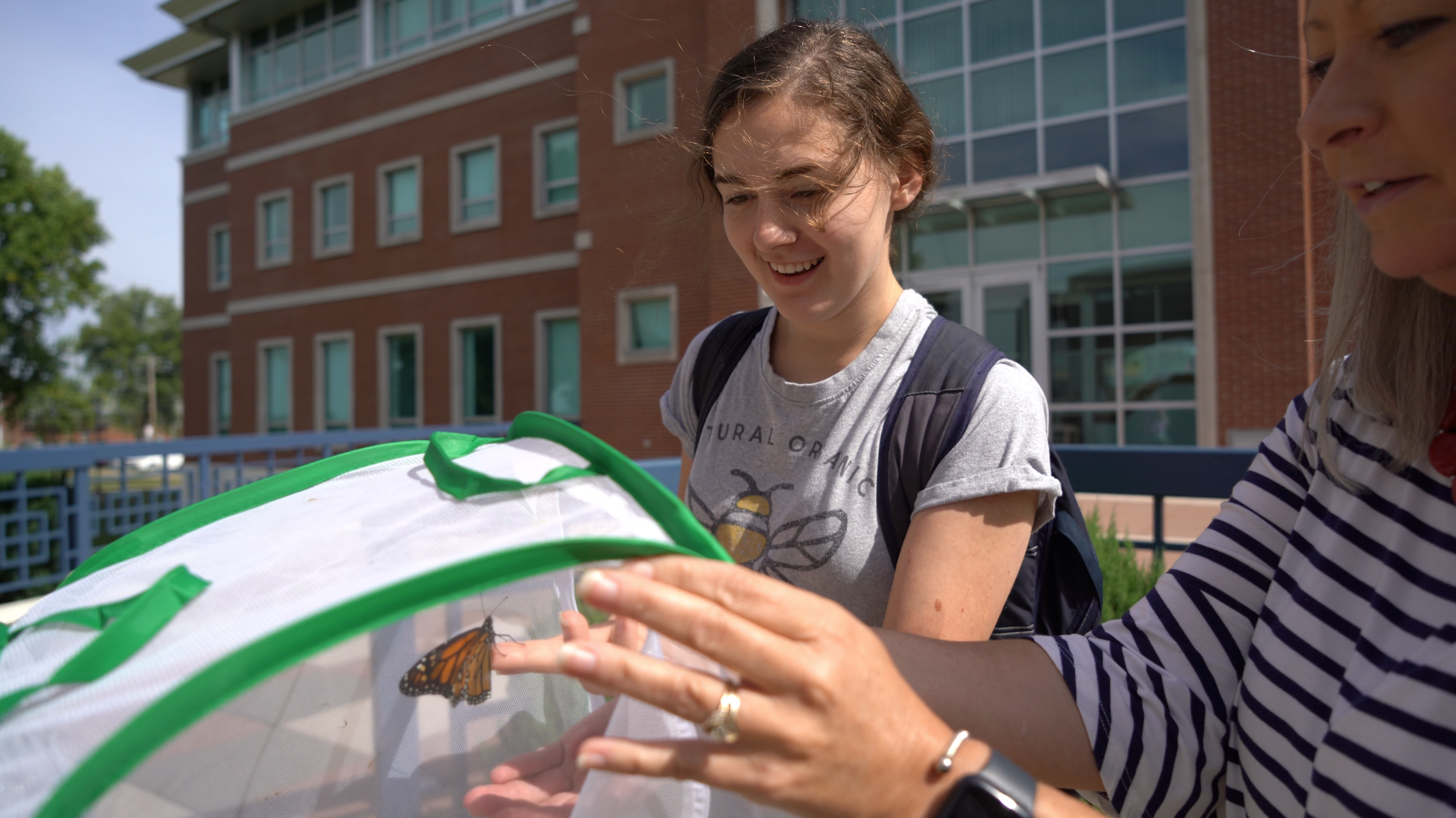Hannibal-LaGrange future science teachers study monarch butterflies

HANNIBAL, Mo. — Five Hannibal-LaGrange University future teachers are studying the life process of the monarch butterfly this fall. The students are in the Teaching Science course taught by Courtney Janes, assistant professor of education.
Janes shared information about how the migratory monarch butterfly has been classified as “endangered” by the International Union for Conservation of Nature. The delicate butterfly can travel nearly 3,000 miles to its overwintering destination in Mexico. During the last three decades, the population of these butterflies has decreased by more than 80 percent, largely resulting from a loss of native plants they feed on.
Monarchs, along with other butterflies, are important as pollinators and a food source for birds, other insects and small animals. This project gives HLGU education students the opportunity to care for the monarch butterfly and do their part in helping to preserve them.
Each student started with at least two caterpillars and some eggs. They have to find milkweed since caterpillars eat two to three milkweed leaves a day. The students carry their mesh cage habitat and floral tube to class. They are journaling what is happening as the monarch butterfly grows from an egg through five growth stages to a mature butterfly.
This is the second year HLGU Teaching Science students have participated in this project.
“I was lucky enough to find a plethora of milkweed,” Janes said in a press release. “Monarch butterflies only lay eggs on milkweed. A lot of butterflies eat other things, but monarch caterpillars only eat milkweed. None of the students had ever taken one and cared for it or hunted for the milkweed, which can be found along the HLGU Nature Trails. They were all nervous about it.”
Janes said students participating in this class are really known on campus. She stated that it is a lot of work to feed the caterpillars. Sometimes students realize at 6 p.m. they have no milkweed and have to find some. The responsibility is kind of like being a parent, Janes said.
Once the monarchs reach butterfly stage, the students release them as a celebration, maybe as bittersweet as a human parent turning their adult children loose in society.
“The students march under the arch (at the Burt Administration Building) and release them. In the fall, monarchs fly to Mexico,” Janes said.
Elementary education major Courtney Bayer said, “I have loved the experience of raising monarch caterpillars. They are very similar to human babies because they are constantly eating. It is amazing watching them grow at such a fast rate. Sometimes I would wake up, and it looked like they had doubled in size overnight. I also had to make sure that they had plenty of milkweed leaves to eat because they would go through several leaves a day as they grew larger. Overall, raising Monarchs was a fun learning experience.”
“We got attached to the butterflies,” said special education/early childhood major Ke’la Zacarias-Campbell, who was a student in the class last fall. “I named the boy ‘Kermit’ and the girl ‘Elsa.’ I didn’t
think it would be so hard to release them, but it was. I’m going to do this again with my little sister. I recommend everyone do it. You can learn a lot.”
Fellow HLGU student Savannah Morton, a special education major, had raised one butterfly from an egg and got a second one three weeks into the growth process.
“I was able to see a lot of stages all at once. As the chrysalis turns green, you can see gold lines and see how they breathe. Sometimes, a chrysalis can be entirely gold. They are absolutely beautiful,” Morton said.
“Courtney has a real passion for teaching,” resident director Kayla Meier said. “It is cool to see the students so excited. The students act like the butterflies are their own kids.”
Meier thought the project would help Janes’ students in leading a STEM (Science, Technology, Engineering, and Math) camp for elementary students.
“This venture has taught me so much about who God is and how he cares for us. It points us to a great creator,” Janes said.
“So far, my experience watching and caring for caterpillars as they transition into monarchs has been amazing,” elementary education major Layla Horn said. “It blows my mind how God can create an animal that literally turns into another animal that is so unique. They are delicate creatures that I have come to find a new appreciation for after raising them.”
Miss Clipping Out Stories to Save for Later?
Click the Purchase Story button below to order a print of this story. We will print it for you on matte photo paper to keep forever.

